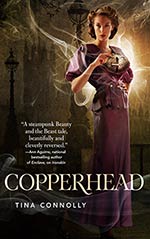
![]() MMOGC
MMOGC
10/28/2013
![]()
Our book club came very close to reading Tina Connolly's Ironskin earlier this year, back when it was one of the choices in our theme for July, which was "2012 Nebula Awards Nominees". We ended up reading another book, but the description of Ironskin had stuck with me ever since. The idea of a gothic fantasy re-imagining of Jane Eyre was just too intriguing to ignore.
So when I received the sequel Copperhead for review, I saw it as the perfect opportunity to check out this author and series, especially after finding out it continues the story in Ironskin but shifts its focus to the protagonist's sister. This means a brand new chapter to this tale, told from the perspective of Helen Huntingdon. It has been six months since her sister Jane uncovered a nefarious fey plot to take over the city, and society is still recovering from the aftermath. It is too late for Helen, who has already traded her old face in for a beautiful fey-charmed one, and now has to wear an iron mask to protect herself and heridentity from being possessed and erased by the bodiless fey.
Jane, however, is determined to help Helen and the other women of The Hundred (society's richest and most priviliged who have opted for fey faces) get their old faces back. As it turns out though, not everyone is so eager to give up their new beauty, and it is up to Helen to try to convince everyone to accept her sister's help. But then Jane goes missing during one of the face-switching procedures, and becomes implicated in a murder to boot. Helen begins her search for answers, leading her down the path towards a confrontation with Copperhead, a group that has risen in recent months with their aims to rid the world of everyone but humans -- even if it means destroying their allies the dwarvven.
What I liked most about this book are the characters. Helen's narration was perhaps the strongest point of the story, and I was sorry not to have gotten to know her before this in Ironskin, because it would have been interesting to see the growth and development of her character over the course of the two novels. Mind you, not that I was disappointed with what I got to see in this book; Helen is an impressive example of female strength, though she is not without her foibles, such as her impulsive nature and her streak of vanity. Reading about her led me to many questions -- the good kind, which reflected my desire to find out more. It made me think that perhaps I should pick up the first book to see how she ended up with her fey face in the first place, or to find out more about the events which led her to marry the aloof and temperamental Alistair. It was clear based on Helen's personality that she was never meant to be with a controlling husband like him, and I liked how she stood up to him in her own various ways, even when she couldn't defy him openly.
Beyond Helen, I also really liked a couple of the other characters. Jane, for example, takes on a supporting role in Copperhead, letting her sister shine instead. But she and Helen are so different, and once again I am curious to go back to the first book and find out more about their relationship. Jane spends much of this book in the background, but it was enough to make me want to get to know her better. Another character who stood out for me was Frye, the forward-thinking actress who is so funny, full of life and unbeholden to societal conventions. She wasn't featured in the book as much as Helen or Jane, but she quickly became a favorite.
On the downside, with so much context built around the characters, I did feel it overshadowed the setting and the world behind these books somewhat. The world building was admittedly a bit on the lighter side, not as robust as I would have liked. It took me a while to get a good feel for the fey threat, and I couldn't grasp the full extent of their impact with the limited information I was given about them and their origins. Despite including flashbacks and explanations, the world also never felt truly fleshed out for me. I was aware that the setting is that of a magical alternate Victorian-era England, but details about it were sparse, making it almost feel removed from everything else while events played out on the page. Perhaps the world building simply felt so much lighter because I'm comparing it to the character development, which I thought was given a lot more attention.
In the end though, this was a great story about an individual taking a stand, of using one's own wits and power to rally support against both a supernatural enemy in the form of the fey, as well as battle a more societal concern, that of oppression and control. I love these characters, and I look forward to checking out Ironskin at a later date so I can fill myself in on rest of the story.
http://bibliosanctum.blogspot.com/2013/10/book-review-copperhead-by-tina-connolly.html